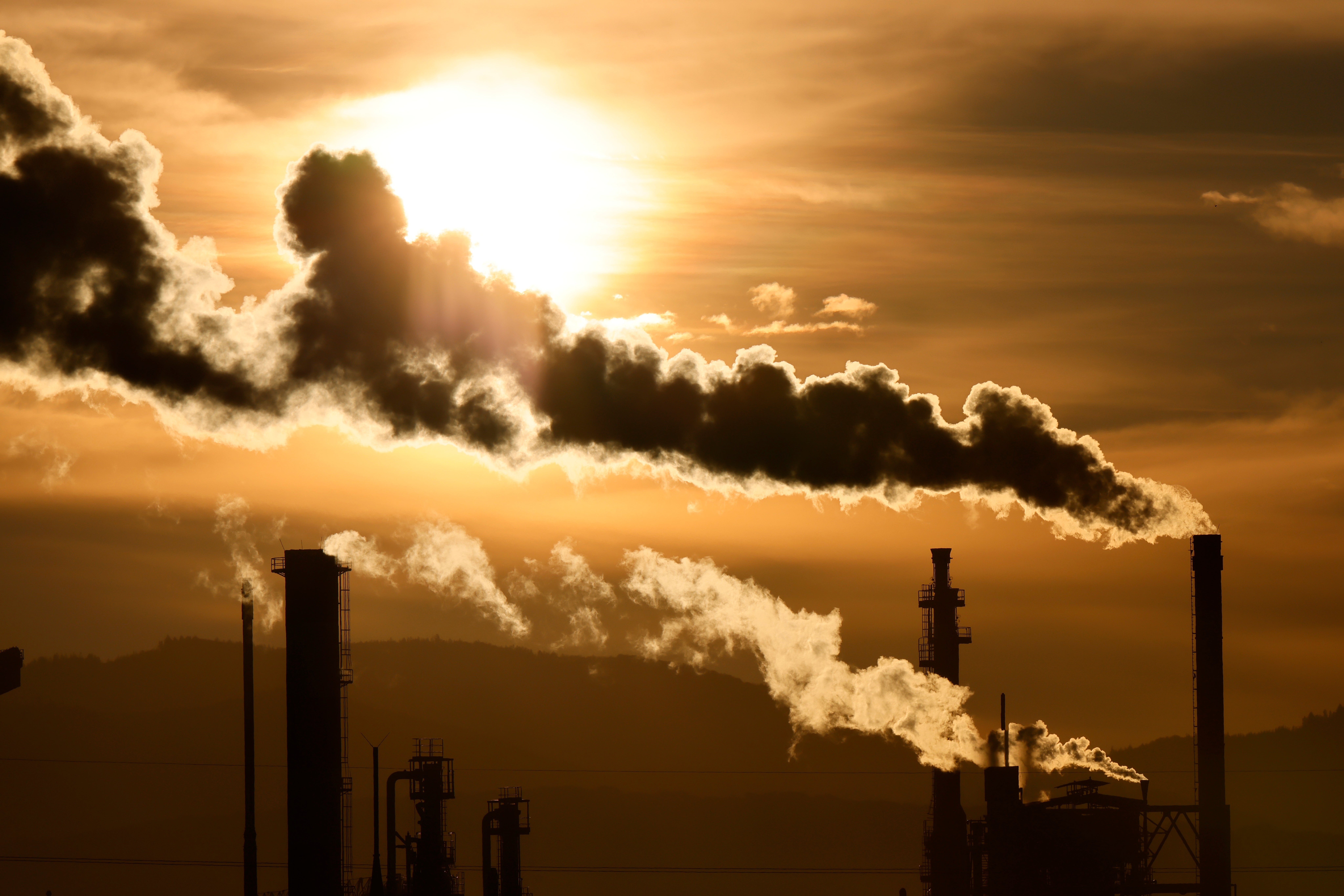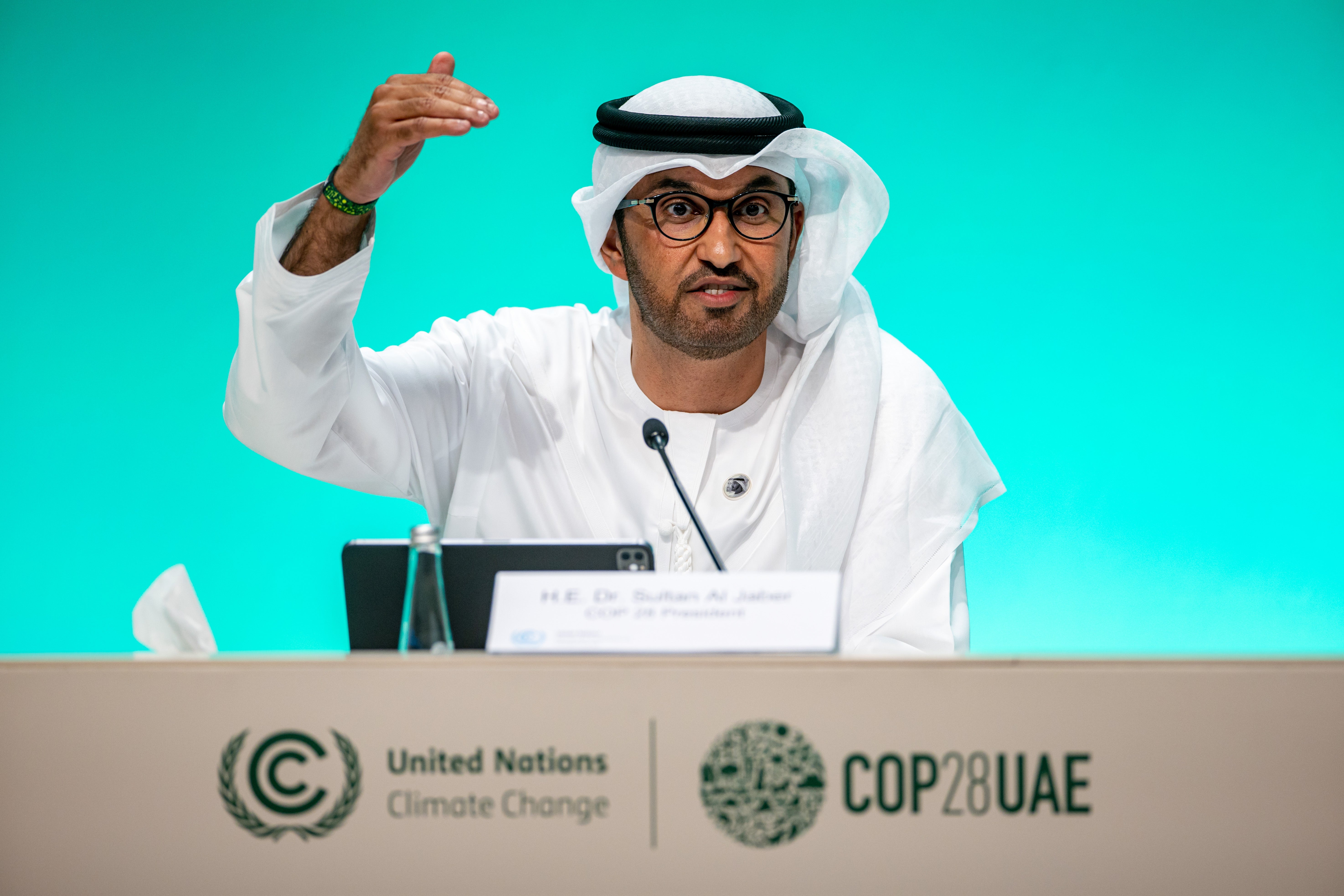The greenhouse gas breakthrough that should give us hope
Three decades on from the first UN Cop summit the world is finally about to hit peak emissions, writes Nick Ferris from the latest summit in Dubai. It is a major milestone but the job of decarbonising our lives is nowhere near complete

Cop28 has been mired in controversy (yes, again) over comments by its host, Sultan al-Jaber, about whether it’s necessary to phase out fossil fuels to limit global warming.
It emerged at the end of last week that he had made comments that there is “no science” behind calls to phase out fossil fuel consumption. But then Jaber, who is also head of the Abu Dhabi National Oil Company, clarified his comments and said that dramatically reducing fossil fuel use was “inevitable” if the world is to keep within 1.5C of pre-industrial levels.
How quickly emissions can be cut – and how – is the key question that the UN climate summit is trying to answer.
Ever since the first Cop in 1992, global emissions have increased each year, with record carbon emissions set to be emitted in 2023. But even if we currently remain well off-track from our long-term climate goals, there are signs that the emissions picture could finally be shifting.
Back in October, the International Energy Agency (IEA) projected in its annual World Energy Outlook that demand for oil, coal, and gas should peak before 2030. Peak fossil fuel demand is a crucial milestone in our journey to net zero, because despite what Jaber may suggest, CO2 released by burning fossil fuels represents around two-thirds of current greenhouse gas emissions, according to the latest science.
Then, last month, a report from climate science institute Climate Analytics proclaimed that 2023 will be the year that the world reaches peak emissions, so long as the adoption of clean technologies like solar panels, wind turbines, and electric vehicles continues to accelerate at the current rate. Pointing out that the IEA has a history of being “conservative” when it comes to policy projections, it anticipates peak coal demand in 2023, peak gas in 2024 and peak oil in 2025.
“Reaching peak global greenhouse gas emissions ... will be a crucial inflection point for the world”, the authors said. “Instead of speeding in the wrong direction, we could finally say we’re making the turn towards our collective climate goals.”
Joeri Rogelj is a world-leading climate scientist based at Imperial College, who is a lead author of both the UNEP Emissions Gap Report, and an author of the Climate Analytics report. Speaking to The Independent at Cop28 in Dubai, Rogelj said that he believes there is plenty of grounds for optimism around global emissions.
“Peak emissions in 2023 is what we expect if things continue on the path they are on right now: with ever more clean technology adopted each year,” he said. “The signs coming from the Cop28 are all positive to that end, with a lot of progress being made on reducing methane emissions [the second most significant greenhouse gas after CO2], as well as the pledge to triple renewables by 2030, which has been signed by more than 100 countries.”
He added: “The data here make me optimistic because it shows we can have a global economy that continues to perform well, and eradicate poverty, while also producing increasingly less emissions. This is a crucial message because it is often used as an explanation or excuse to not reduce emissions.”
Delving into some of the other climate data released ahead of Cop28 allows us to better understand why we could be at the point of peak emissions.
Data from the IEA shows that global investment in clean energy is to hit $1.8 trillion in 2023, a figure 40 per cent higher than the equivalent for 2020. Much of this is being driven by two factors: booming EV sales and booming renewables.
Car sales in the first half of 2023 were 18 per cent electric vehicles (EVs), with EVs now making up 24 per cent of the car market in the EU, and 31 per cent of the market in China. Meanwhile, wind and solar reached a record 12 per cent of global electricity in 2022, according to the think tank Ember, with 107 economies now past “peak” fossil fuel electricity.
Ember believes electricity sector emissions may now have peaked; we know for a fact that they did so in Europe more than a decade ago.
The good news is that declining CO2 emissions will have an immediate, tangible impact on climate change. This is because the way that CO2 operates means that there is not a large amount of additional warming expected from carbon levels already recorded in the atmosphere.
“Once we reach net zero, our best understanding is that global warming related to CO2 will stop where it is: It won’t get any better, but it won’t get any worse either,” said Rogelj. “If we keep emissions within the 1.5C carbon budget – which is the stated aim here at Cop28 – then the warming will stay at 1.5C; it won’t get any worse.”
However, none of these positive signs mean that the job of decarbonising is anywhere near completion.
Even in the “continued acceleration” trajectory that the authors of the Climate Analytics report say we are currently on, the 10 per cent fall in emissions by 2030 relative to 2019 remains well off the 43 per cent cut that the Intergovernmental Panel on Climate Change (IPCC) says we must achieve to keep the Paris Agreement goal within reach. The authors add that global clean energy investments need to be ramped up two-and-a-half fold, with the greatest increases happening in emerging economies.
The progress that has been made on emissions is also largely focused on easier-to-abate areas like electricity generation. Headline emissions reduction figures can often hide the fact that little progress is being made in areas considered “hard to abate”.
The EU may have reduced emissions by 32 per cent since 1990, according to European Commission data, but this masks the fact that emissions have actually increased in the transport sector, driven by the aviation and shipping sectors, which have no simple decarbonisation pathway. Indeed, data shows that emissions from European aviation have doubled over the period.
“Emissions make good headlines, but really what matters is what happens underneath,” said Rogelj. “And if you look at countries that have peaked, you can see there is a pattern where energy sector emissions have peaked, which is driven by the roll-out of renewables that are now much cheaper than fossil power. But progress is much slower in sectors like transport and in industry.”
Even if peak emissions are met this year, there is also nothing to guarantee that it will be followed by a rapid decline, which is what would be required to meet the ambitions of the Paris Agreement.
Historically, when technologies have peaked and declined, they have followed what is known as a “hockey stick curve”, which follows the pattern of levelling off, before a rapid decline.
Peak demand for gas lighting in the UK came in 1907; for UK steam power in 1910; and for UK coal heating in around 1960. These systems followed that hockey stick curve, with a plateau for a number of years, followed by a rapid decline. This last period is associated with collapsing profits, stranded assets and companies going bust. The cost of investment rises for industries that have peaked, starving them of the ability to invest, and accelerating their decline.

But the IEA has warned in its latest outlook that oil and gas demand looks likely to remain constant for some time after its peak, limiting the ability of emissions to follow a trend of rapid decline. This is because increases in consumption in developing countries will offset decreases recorded in developed countries.
For Armond Cohen, executive director of the global non-profit Clean Air Task Force, this failure to account for demand in developing countries is often a major oversight in models looking at peak emissions.
Speaking to The Independent in Dubai, Cohen suggested that models showing a rapid decline in emissions following a peak typically “assume that there won’t be much demand for fossil fuels in the developing world, even 30 years from now”.
“Data shows us that demand for fossil fuels in developing and industrialising economies continues to grow rapidly. But the problem with so many models is that they assume continued suppressed demand in these parts of the world, which is hard to envisage if you expect these countries to continue to develop,” he said.
“I hope that I am wrong: I hope that the more optimistic studies we are seeing on emissions are proved correct. I would also agree with others when they say that progress in renewables and renewables and electric vehicles is very promising.
“But my main message is to not be complacent: even if there is some marginal improvement in the data, the energy transition is complicated and expensive, and it will require us to continually throw everything we have at it if it is to work out.”






Join our commenting forum
Join thought-provoking conversations, follow other Independent readers and see their replies
Comments